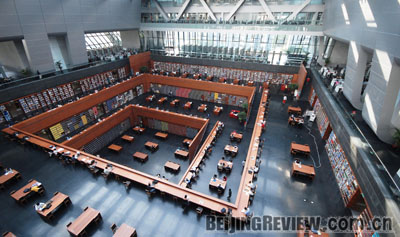|
 |
|
ILLUMINATED PLACE: People read in natural light in the energy-efficient new library building (WEI YAO) |
The NLC also plans to build a search engine like Google. Compared with Google, the engine of the NLC will supply readers with more efficient, accurate and customized information, while screening junk information.
Library highlight
A big attraction in the new NLC building is Si Ku Quan Shu, a rare set of Chinese classical books that used to be stored in the original NLC building. The set is one of the most precious treasures of the library, and is presented to the public for the first time in history.
The set of books, completed in the 37th year (1772) under the reign of Emperor Qianlong of the Qing Dynasty (1644-1911) contains four traditional Chinese learnings-classic, history, philosophy and belles-letters. It's the largest series of traditional Chinese classics before the Qing Dynasty. The set has a total of 36,304 volumes. It takes 3,826 people to make handwritten copies.
Of all the seven original copies, only 3.5 have survived, according to Zhao Qian, Associate Researcher in the NLC. The copy stored in the library was originally kept in the Palace Museum.
The new home of the classical books is located on sublevel one of the new building, and has an area of more than 500 square meters. The set of books occupy 128 bookshelves.
Until recently the public was unable to see the complete set. Now, at a designated time on important holidays, readers can view the books behind a glass wall. On other days, the storage area is closed to the public.
To protect the books, the storage area has equipment to maintain constant temperature and humidity, and to protect the storage against fire, theft and ultraviolet rays. The firefighting device is the most advanced gas extinguishing system. Thirty seconds after the sounding of an alarm, the gate closes automatically, and solid carbon dioxide is jetted to extinguish the fire. Gas was selected because it causes minimal harm to people and to the collection.
A Brief Introduction of the National Library of China
The National Library of China was built on September 9, 1909, and was
officially opened to the public on August 27, 1912. In the 1920s, the library started to collect books written in foreign languages. It is the largest
depository of classical foreign books or periodicals in China. It also has a large collection of publications of international organizations and foreign
governments. As of the end of 2007, the library had a total collection of 26
million volumes/items. Its collection of Chinese documents and information
was the largest in the world, while its collection of foreign-language books
was the largest in China.
Below is an inventory of the library's collections as of the end of 2007
Chinese books: 4,732,210 volumes, including Chinese books published in China and overseas.
Foreign-language books: 3,410,844 volumes in English, French, German and many other languages.
Chinese periodicals: 50,283 titles, 6,070,670 volumes
Foreign-language periodicals: 46,108 titles, 6,443,569 volumes
Chinese newspapers: 7,553 titles, 105,248 bound volumes
Foreign-language newspapers: 1,699 titles, 89,881 bound volumes
Ancient rare editions: Ancient rare editions in mandarin Chinese, more than 270,000 volumes; materials in minority languages, 151,873 volumes/items
Microfiche: 1,346,547 reels /copies/sheets
Publications of international organizations and foreign governments: More than 500,000 items
Audio material: More than 40,000
Visual material: More 100,000 copies/discs/boxes
Database: 127 databases, purchased, self-constructed or acquired through other means
(Source: The National Library of China) | 